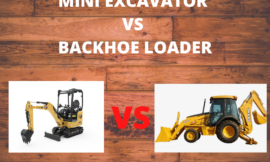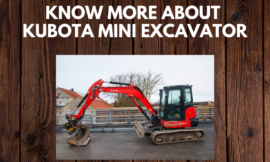Excavators are the go-to hydraulic shovels for medium to large construction projects. Their efficiency and mobility are very essential to most construction projects of all types.
e.g. trenching, dredging, demolition, land clearing, road excavation, etc
But what happens when your construction project is small scale? What if you need an extra machine for some smaller jobs but you don’t need so much as a full standard excavator?
Thankfully, excavators come in much smaller, compact sizes called “compact excavators”.
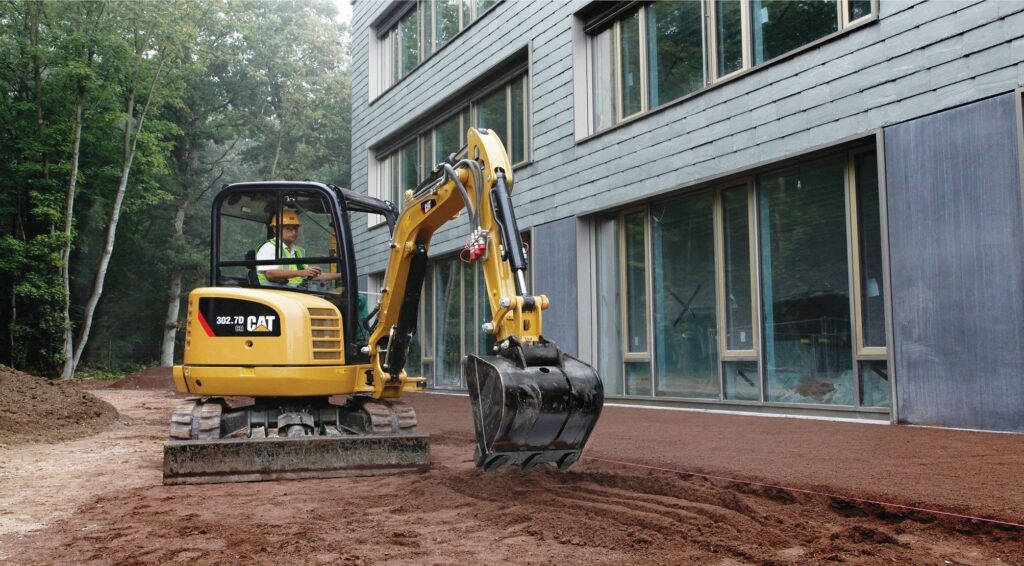
Mini excavators have become very popular today in small and medium scale construction projects because they pack a lot of power and have a very wide range of uses, while still being able to fit into the tightest of spaces.
Their functionality and maneuverability also makes them useful in large scale operations as they can be used to demolish smaller structures and they can also reach tight confined spaces.
Their weight and the use of tracks makes them able to work on almost any type of terrain without difficulty. Some mini-excavators also feature “Zero tail swing” which allows them to work close to other objects like buildings and machinery without hitting them because the mini-excavator’s housing never extends beyond the machine’s tracks.
Today, we are going to be covering a list of topics that will help you decide if a mini-excavator is what you need for your next project.
What’s a mini excavator ?
A mini-excavator is basically the same with a standard excavator, only much smaller. It features a boom, dipper(stick), bucket and a rotating cab that can rotate a full 360 degrees.
Mini excavators, sometimes called “Compact Excavators” generally weigh much less than standard excavators, although there are compact excavators that weigh up to 12,000 pounds. In fact, the smallest mini-excavator can fit through a door hole.
Mini-excavators, like most of their bigger counterparts are fully hydraulic. This means that all parts of the machine are powered by hydraulics including the slew, boom, tracks, propulsionnaire hydraulic, and almost all of their attachments etc.
Their smaller size makes them more applicable in small-medium construction projects and one major benefit of Small excavators is that they are very mobile and perform very well in high traffic work-sites.
Another benefit is that mini-excavators can easily transported between project sites.
Mini-excavators despite their smaller size still pack a lot of power and versatility. Smaller model Small excavators(4000-6000 pounds) can dig a 10ft deep hole while larger models(10,000-12,000 pounds) can dig a 14 foot hole.
The combination of small size and their tracks produces very little ground pressure which makes them able to work in very fragile ground conditions and tracks ensure that they can work with almost any terrain.
Some mini-excavators come equipped with cushion for their boom, stick and bucket cylinders.
This eliminates jolting at the end of each stroke. Operators can also configure the blade’s working position through the use of angled blades.
Many compact excavators come with retractable under-carriages and that allows the operator to retract the under-carriage while working in small, confined spaces.
They can later expand the undercarriage which adds stability to the machine.
Working Of a Mini-Excavator :
Types of Mini-Excavators
Mini-excavators are generally classified according to the following factors :
- Maximum dig depth : This refers to how far below the excavator the bucket can dig.
- Maximum cutting height : This refers to how high the bucket’s tip can go
- Power rating : This means the overall engine power of the excavator
Why use a Mini-Excavator ?
Now you may be wondering whether a mini-excavator is what you need for your next project. Well here are a few reasons that a mini-excavator might be the perfect choice .
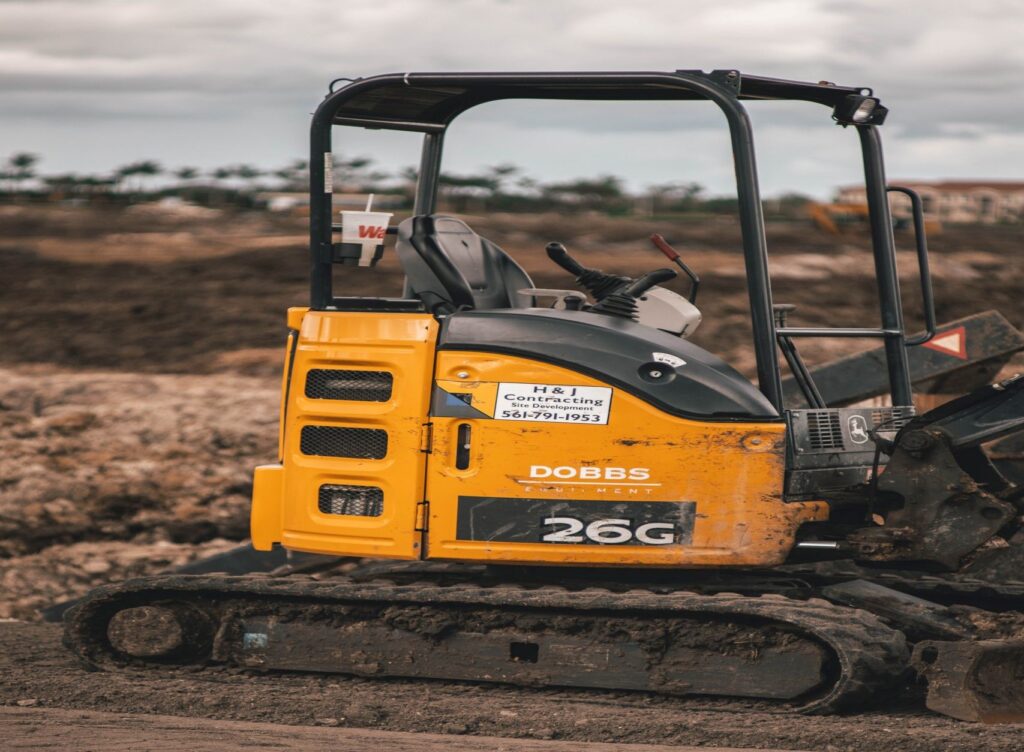
Small Size
Compact excavators are only “mini” in size. When it comes to power, they pack a punch!!! Their small size is an advantage because they can go where other large machines e.g standard excavators cannot go.
It’s why Small excavators are excellent at jobs that are in confined spaces like narrow roads and near buildings.
Versatile
Small excavators can be fitted with a very wide range of attachments that do different jobs. The result is a machine that can go almost anywhere and do most types of heavy machinery jobs.
No wonder Small excavators are applied in so many areas like forestry, snow-clearing, demolition, digging trenches, etc.
More Efficient
When it comes to small scale heavy machinery work, compact excavators tend to be more fuel-efficient and environmentally friendly than standard excavators.
More Cost-Efficient
When it comes to small-medium scale construction projects, compact excavators get the job done with less capital costs.
Small excavators also require less fuel and they have higher durability which saves money on repairs and replacements.
Uses and Applications of a Mini-excavator
Small excavators are perfect for a wide range of construction projects. Their small size and versatility makes them ideal for different types of construction projects.
Some common examples include :
Digging :
Being diggers, compact excavators excel at digging and they do so with efficiency and effectiveness that shoveling can’t compare with.
They also offer the advantage of being able to get into hard to reach places at the work-site. Combined with the wide range of attachments, Small excavators can greatly reduce digging time.
They can be used to dig irrigation ditches.
Landscaping :
In gardening, hand shoveling can easily be replaced with compact excavators with the added benefit of being able to get the job done quicker and also saves labor.
Brush cutters can be attached to mow overgrown lawns and weeds. Also, some very lightweight excavators can move around your property with little to no damage to soil and plants.
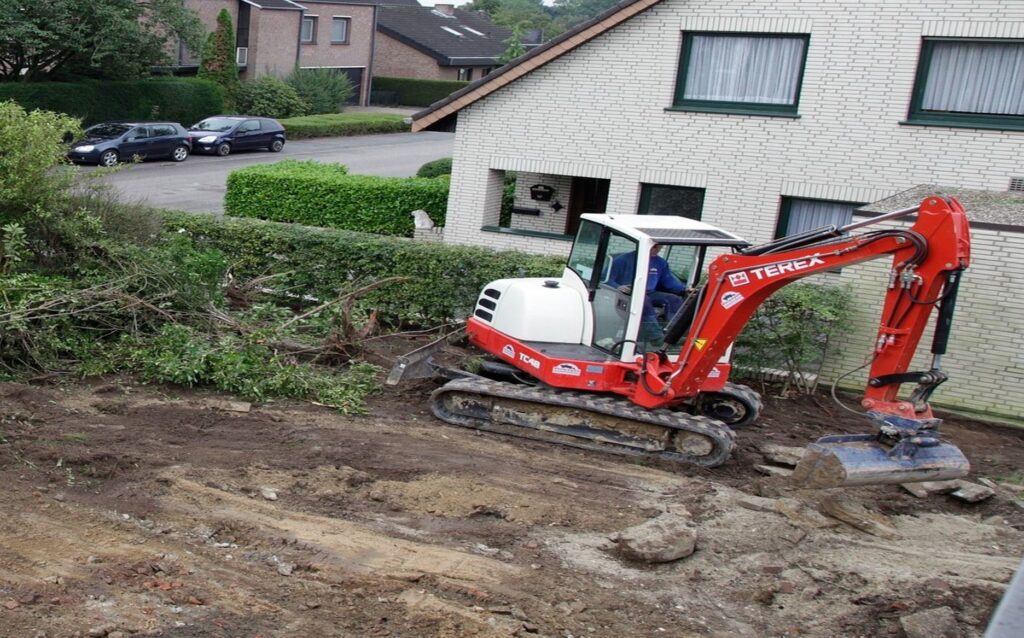
Demolition Jobs
Though not suited to large building demolition, mini excavators still work well for demolitions. They are useful to demolishing smaller structures like small buildings, sheds, etc.
Also, their “mini” size makes them able to move through close spaces and gates.
Installing hot tubs and pools
Compact excavators are perfect for installation of small structures like pools and hot tubs.
They excavate dirt much more quickly than shoveling and they won’t have a problem trying to get to the job site.
Forestry
Small excavators are also very useful in forestry project as they have a wide range of attachments like grapples for picking logs of wood.
They are sometimes used to slump over smaller trees. When a disc mulcher is attached, the mini excavator can work through different tough areas like thick forests, narrow forests routes and bush terrains.
Agriculture
Farming is another area where compact excavators thrive excellently. They move large amounts of hay and straw easily using “Bale spears”.
They use “Augers” to dig holes and fence-posts.
They also control grass and weeds through the use of brush-cutters. Lastly, they can be fitted with rake boxes for preparing land and smoothing it out.
Plumbing
Mini-excavators are able to dig trenches quickly and easily which makes them suitable for plumbing projects.
They can also be used to reach pipes and lines for repair. E.g. sewer lines
Waste recycling
Most standard excavators struggle on landfill and recycling areas. Mini-excavators, however, do better because of their smaller size and their use of continuous tracks.
Plus, the back-fill blade can also be used to stabilize the machine while digging.
Roadside digging
compact excavators are the perfect machine for road side digging. Their small weight means they can be operated on roads. Also, their small size means they won’t take up much space and won’t affect traffic.
Small excavators that offer “Zero tail swing” offer added maneuverability and can work in the tightest of spaces.

Snow Clearing
Winter months are full of snow-covered roads. compact excavators make snow clearing easier as they can move around snow-covered roads faster due to their small size and low weight.
Also mini excavators with “Zero-tail swing” can work around tight spaces around buildings and other vehicles with comfort as their housing never extends beyond their tracks.
When a ripper is attached, a mini-excavator can work more easily in snow-dense areas and even permafrost making the mini-excavator invaluable in snow-clearing.
Attachments of Mini-Excavators and Their Uses
Mini-excavators, like their cousins (“Standard Excavators”) can be fitted with a wide range of attachments and this results in wider versatility for the Small excavators. They are two major types of attachments for mini-excavators; digging.
Some common attachments used with compact excavators include :
Hydraulic breakers
Some times the material to be moved involves concrete or asphalt. To break up the material efficiently for excavation, a hydraulic breaker is used.
It acts as a hydraulic hammer that exerts enough force on hard materials like concrete and asphalt. This makes excavation easier in concrete dense areas.
Newer hydraulic breakers come with long-stroke piston that increases energy transfer and reduces recoil.
Trench buckets
Trench buckets are more suitable for digging as they can dig narrow and deep trenches. When working in tough ground conditions, adding side plates will boost life-span of the bucket.
The size of the buckets reach up to 72 inches, although most mini-excavator owners don’t need more than 48 inches. A quality trench bucket cost as much as $700 to $3000.
Grading Buckets
Grading buckets are a perfect for job-sites where buckets with teeth are forbidden. Grading buckets can be used to add contours for better drainage.
Grading buckets that come with a smooth lip can be used to back-fill, clean and level ditches. They can also be used for finish grading.
Tilting Buckets
commonly utilized in grading operations. Tilting buckets can be tilted 45 degrees in both directions. They are good at maintaining the trench level when the machine is positioned at an angle.
Tilting buckets are powered and controlled by the auxiliary hydraulic circuit. Their hydraulic requirements are significant and so they are mostly only available. Mini-excavator tilting buckets costs around $500 – $1,200.
Plate compactors
Plate compactors offer the operator the ability to compact soil on slopy and difficult to reach areas in a more efficient way than hand-operated compactors.
This removes the need for a worker in the trench. The price of plate compactors is between $5,400 – $8,000 apiece.
Augers
Augers offer more precision in terms of digging. Augers can dig marked holes for trees, piers, fence-posts, etc.
Augers also increase the reach of the excavator and that reach is useful in tricky jobs like reaching an area from the side only. The auger can also be lifted over shrubs, holes and fences.
Augers, with mounting frames typically cost about $1,200 to over $3,000.
Clamps and Thumbs
Clamps are used to transport materials that don’t fit easily in a bucket. Clamps can be used to pick up and move irregular objects like huge rocks, tree stumps.
It is generally used to prepare the job-site for operations like trenching and landscaping.
Rippers
Rippers are used to cut through frozen ground and other difficult terrain. They can be used on permafrost, shale and topsoil. Rippers are also very effective for preparing tough soil for excavation.
A mini-excavator ripper costs between 500 – 2600 for smaller models while larger models cost between $10,000 – $30,000.
Rakes
Rakes are attached to compact excavators to clear land, sift rock and debris, prepare the site, and for brush piling.
A mini-excavator rake costs around $200 to $600 for smaller models while larger models costs around $800 – $2000.
Quick Couplers
Quick couplers make it easier to change attachments without the need to remove pins. Hydraulic quick couplers make it easy to change attachments with the push of a button.
Hydraulic quick couplers for Small excavators costs between $30 – $200.
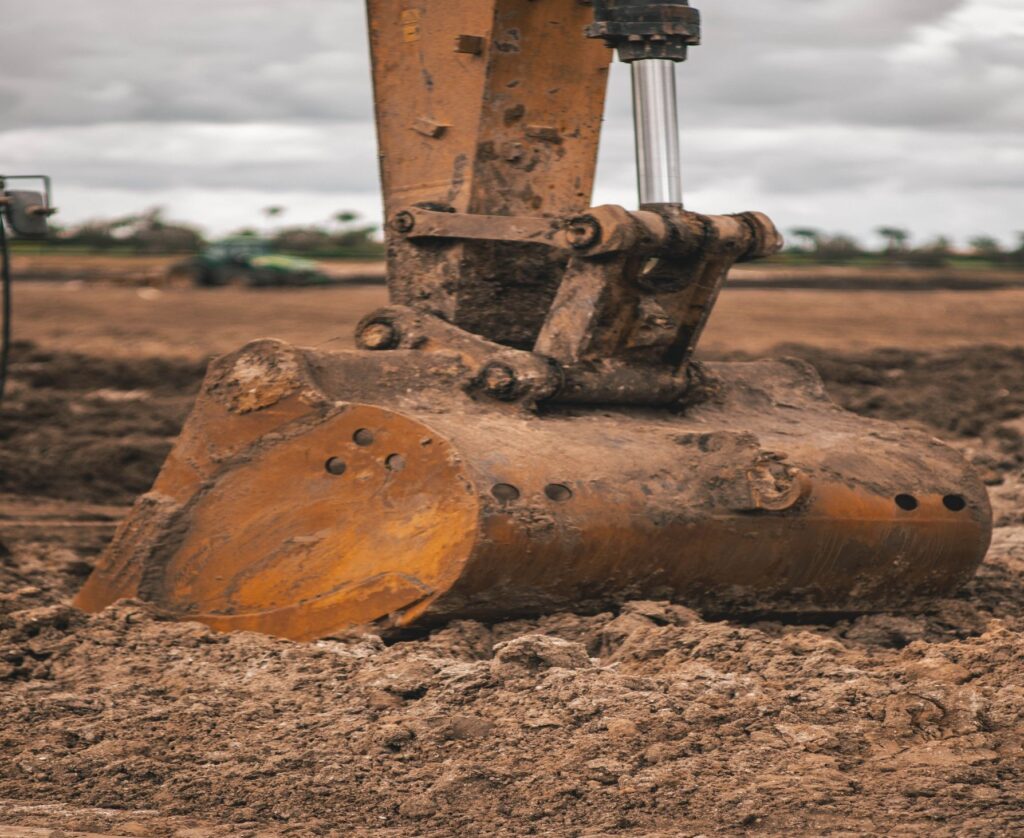
Heavy-duty buckets
These buckets are made for digging and loading in rock-filled areas or areas that make wear and tear easier. These buckets are made of quality high-strength steel.
They are best suited to excavation sites with tough soil with shot rocks but they are not suitable for digging through solid rock. A mini-excavator heavy duty rock bucket costs around $2,000 – $6,000.
Mulchers
Sometimes called “Stump grinders” are commonly used in landscaping, land clearing and agriculture.
Mulchers are used to grind bushes, stumps, etc. Some mulchers come with advanced load-sensing systems which match the rotor’s pace to the type of job.
A mini-excavator mulcher costs around $1,500 and $6,000 for smaller models while larger models costs around $9,000 to $20,000.
Shears
Shears are commonly used in construction jobs. They are used to demolish steel and concrete buildings, cutting metal wires and poles and sheets.
Shears can also be applied in agriculture for land clearing. Mini-excavator excavator shears costs between $1,500 to $3,000 for smaller models while larger models costs between $8,000 and $22,000.
Tilt-rotator
Is attached to the excavator to enable the bucket or any other attached tool to tilt 45 degrees in any direction and rotate up to 360 degrees, effectively allowing the machine to work in a variety of angles without needing to reposition the machine.
A tilt rotator costs between $11,000 to $20,000. Some excavator operators claim that tilt rotators increase efficiency by as much as 40%.
Water Mist System
Excessive exposure to crystalline silica in the air has been linked to lung diseases and OSHA requires that project managers reduce their workers’ exposure to crystalline silica.
Water mist systems are designed to be used with breakers. They spray water which reduces the amount of dust and silica in the air.
Drum-cutters
These are built for rock and concrete wall trenching, foundation laying, demolition, excavating rock and dredging operations.
Many drum cutters come with a central fixing system that enables the drum cutter to rotate a full 360 degrees while still being connected to the excavator.
Dust suppression systems can also be added onto the drum cutter to reduce silica release. Some drum cutters have low vibrations and low noise while in operation.
An average mini-excavator drum cutter costs between $8,000 to $10,000 for smaller models while larger models (1000 kg above) costs between $24,000 to $42,000.



